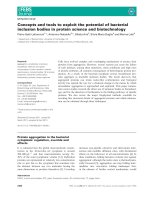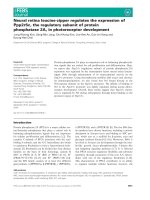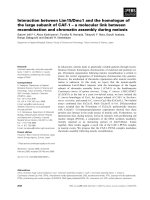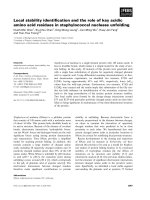Báo cáo khoa học: "Is it time to increase the frequency of use of high-frequency oscillatory ventilation" pps
Bạn đang xem bản rút gọn của tài liệu. Xem và tải ngay bản đầy đủ của tài liệu tại đây (34.28 KB, 2 trang )
339
ARDS = acute respiratory distress syndrome; HFOV = high-frequency oscillatory ventilation.
Available online />Abstract
In this issue of Critical Care, Bollen and colleagues present the
results of a multicentre randomised controlled trial, comparing
high-frequency oscillatory ventilation with conventional ventilation
as the primary ventilation mode for adults with acute respiratory
distress syndrome. The study was stopped early after recruiting
only 61 patients because of declining enrolment, and although no
differences were detected in any primary or secondary endpoint,
this trial only had sufficient power to detect extreme differences in
outcomes between groups. This editorial attempts to put these
results in context with previous work and highlights challenges to
be addressed in future studies.
Recognition of the impact of ventilator-induced lung injury on
morbidity and mortality in patients with acute respiratory
distress syndrome (ARDS) has led to an ongoing search for
ventilation strategies that limit further damage to the already
injured lung. In this issue of Critical Care, Bollen and
colleagues [1] present the results of a multicentre randomised
controlled trial, comparing high-frequency oscillatory ventila-
tion (HFOV) with conventional ventilation as the primary
ventilation mode for adults with ARDS.
HFOV applies a continuous distending pressure to the lung
around which pressure oscillations are generated. These
pressure swings are attenuated by the time they reach the
alveolar level, resulting in very small delivered tidal volumes.
HFOV is theoretically ideal for lung protection, as this minimal
tidal variation in alveolar volume may allow clinicians to recruit
the lung, minimising atelectrauma and oxygen toxicity, while
still avoiding volutrauma from tidal overdistension. However,
potential drawbacks to HFOV also exist, most notably the fact
that the majority of adults must have their spontaneous
respiratory efforts suppressed since their inspiratory flow
demands are often greater than the constant flow of gas in
the circuit. This need for heavy sedation (and frequently
neuromuscular blockade) means that HFOV may not be an
appropriate therapy for patients with mild forms of acute lung
injury.
An extensively studied and accepted therapy in neonates [2],
HFOV is still an emerging ventilator mode in adults. Previous
work in this area has shown that HFOV is safe and effective
in improving oxygenation in ARDS patients who are failing
conventional ventilation [3-5]. However, when HFOV is
considered as a primary ventilatory mode to prevent
ventilator-induced lung injury, only one clinical trial has been
previously published [6]. Mortality was not the primary
outcome of this study and the control group arguably did not
receive what would today be considered optimal conventional
ventilation; nevertheless, a tantalising trend towards improved
mortality was seen in the HFOV group of this study [6].
Consequently, HFOV in adults with ARDS remains a therapy
with significant potential, but one requiring considerably more
data before it can be endorsed for routine use.
In the study under consideration, Bollen and coworkers set
out to determine the effect of HFOV on the rate of survival
without mechanical ventilation or oxygen dependence at
30 days, compared with conventional ventilation [1].
Unfortunately the trial was stopped early, after recruiting only
61 patients because of declining enrolment, and a further
11% of subjects had incomplete follow-up for the primary
endpoint. Although no differences were detected in any
primary or secondary endpoint, this study only had sufficient
power to detect extreme differences in outcome between
groups. This low power was further eroded by the fact that
Commentary
Is it time to increase the frequency of use of high-frequency
oscillatory ventilation?
Jeffrey M Singh
1
and Niall D Ferguson
2
1
Lecturer, Interdepartmental Division of Critical Care Medicine, and Department of Medicine, Division of Respirology, University Health Network,
University of Toronto, Toronto, Ontario, Canada
2
Assistant Professor, Interdepartmental Division of Critical Care Medicine, and Department of Medicine, Division of Respirology, University Health
Network, University of Toronto, Toronto, Ontario, Canada
Corresponding author: ND Ferguson,
Published online: 24 June 2005 Critical Care 2005, 9:339-340 (DOI 10.1186/cc3761)
This article is online at />© 2005 BioMed Central Ltd
See related research article by Bollen et al. in this issue [http://ccforum/content/9/4/R430]
340
Critical Care August 2005 Vol 9 No 4 Singh and Ferguson
18% of patients crossed over to the alternative therapy,
making detection of a difference between groups highly
improbable.
Interpretation of these results is further complicated by the
fact that the two treatment groups differed significantly in
numbers as well as in baseline hypoxia (oxygenation index of
25 in the HFOV group, versus 18 in the control group).
Furthermore, comparison and integration of these results with
the existing body of knowledge regarding HFOV in ARDS are
made more difficult by the lack of very explicit ventilation
protocols. Because it is very clearly how a ventilator mode is
used, not just which mode is chosen, clear descriptions of
the ventilator protocols and the adherence to them are
essential for interpreting the results of comparative trials of
ventilation strategies and modes.
Despite these limitations, the study does generate some new
hypotheses. In a post hoc analysis, the authors found that the
subgroup of patients with the most severe hypoxaemia
(highest oxygenation indices) tended to benefit from HFOV
compared with those undergoing conventional ventilation. As
discussed by the authors, this finding may relate to the fact
that the ‘safe’ window for lung protective mechanical
ventilation, in which both overdistension and cyclical tidal
recruitment and derecruitment are avoided, is so narrow in
severe lung injury that conventional ventilation is no longer
able to accomplish the goals of lung protection. The implica-
tions of this finding are for future investigators to consider
stratifying the randomisation of patients by oxygenation index,
or indeed to limiting enrolment to those patients with the
most severe forms of ARDS [7]. The potential benefits of this
latter decision in terms of potential increased effect size
would need to be weighed carefully with an inevitable
decrease in the number of potential study patients, which
might threaten both the feasibility and generalisability of the
study [8]. Indeed, another important lesson from this study is
that future randomised trials must be collaborative multicentre
efforts, because even in centres with a special interest in
ARDS a realistic estimate of the recruitment rate into such
trials is somewhere in the range of one patient every other
month [1,6].
Ultimately, many of the questions regarding the use of HFOV
in patients with ARDS remain unanswered: in which patients,
at what time and using what settings should HFOV be
applied? Several studies have documented worse outcomes
when patients received longer periods of conventional
ventilation before initiation of HFOV, suggesting that an early
transition to HFOV might be needed [3-6]. Lung volume
recruitment is vital in HFOV and is affected by both the HFOV
settings and the use of lung volume recruitment manoeuvres.
A strategy targeting lung volume was instrumental in the
successful application of HFOV in newborn infants [9], and a
comparable protocol has been found to be safe and effective
in adults [10]. The decision and method of weaning HFOV
back to conventional mechanical ventilation are even more
indistinct, with no clear direction with respect to the priority of
airway pressure, frequency and pressure amplitude (∆P) in
weaning. These issues only underline the importance of
explicit ventilation protocols so as to standardise across
treatments and allow comparison between them.
Although the utility of HFOV as rescue therapy is clearer, its
precise role as primary therapy in patients with ARDS
remains unclear. The trial by Bollen and colleagues serves to
demonstrate the challenges and complexities in studying
mechanical ventilation protocols in a heterogeneous
population of sick patients, and the necessity for explicit
protocols to guide treatment and experimental methods.
Competing interests
The author(s) declare that they have no competing interests.
References
1. Bollen CW, van Well GT, Sherry T, Beale RJ, Shah S, Findlay GP,
Monchi M, Chiche JD, Weiler N, Uiterwaal CS, et al.: High fre-
quency oscillatory ventilation compared with conventional
mechanical ventilation in adult respiratory distress syndrome:
a randomized controlled trial. Crit Care 2005, 9:R430-R439.
2. Froese AB, Kinsella JP: High-frequency oscillatory ventilation:
lessons from the neonatal/pediatric experience. Crit Care
Med 2005, 33:S115-S121.
3. Mehta S, Granton J, MacDonald RJ, Bowman D, Matte-Martyn A,
Bachman T, Smith T, Stewart TE: High-frequency oscillatory
ventilation in adults: the Toronto experience. Chest 2004,
126:518-527.
4. Fort P, Farmer C, Westerman J, Johannigman J, Beninati W, Dolan
S, Derdak S: High-frequency oscillatory ventilation for adult
respiratory distress syndrome – a pilot study. Crit Care Med
1997, 25:937-947.
5. Mehta S, Lapinsky SE, Hallett DC, Merker D, Groll RJ, Cooper
AB, MacDonald R, Stewart TE: A prospective trial of high fre-
quency oscillatory ventilation in adults with acute respiratory
distress syndrome. Crit Care Med 2001, 29:1360-1369.
6. Derdak S, Mehta S, Stewart TE, Smith T, Rogers M, Buchman T,
Carlin B, Lowson S: High frequency oscillatory ventilation for
acute respiratory distress syndrome: a randomized controlled
trial. Am J Resp Crit Care Med 2002, 166:801-808.
7. Ferguson ND, Kacmarek RM, Chiche JD, Singh JM, Mehta S,
Hallett DC, Stewart TE: Screening of ARDS patients with stan-
dardized ventilator settings: influence on enrollment in a clini-
cal trial. Intensive Care Med 2004, 30:1111-1116.
8. Sackett DL: Why randomized controlled trials fail but needn’t:
2. Failure to employ physiological statistics, or the only
formula a clinician-trialist is ever likely to need (or under-
stand!). CMAJ 2001, 165:1226-1237.
9. Gerstmann DR, Minton SD, Stoddard RA, Meredith KS, Monaco
F, Bertrand JM, Battisti O, Langhendries JP, Francois A, Clark RH:
The Provo multicenter early high-frequency oscillatory ventila-
tion trial: improved pulmonary and clinical outcome in respira-
tory distress syndrome. Pediatrics 1996, 98:1044-1057.
10. Ferguson ND, Chiche JD, Kacmarek RM, Hallett DC, Mehta S,
Findlay GP, Granton JT, Slutsky AS, Stewart TE: Combining
high-frequency oscillatory ventilation and recruitment maneu-
vers in adults with early acute respiratory distress syndrome:
the Treatment with Oscillation and an Open Lung Strategy
(TOOLS) Trial pilot study. Crit Care Med 2005, 33:479-486.









